Controversial theories of human origins,
mixed with a measure of coincidence,
and sprinkled with prose and fantasy.
Lessons of the Tyrolean Iceman
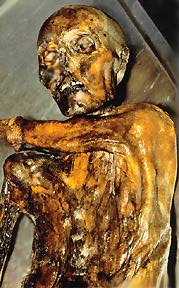 Turns out we can learn a lot from Frozen Fritz. Also called Oetzi, the iceman recovered from the Austrian alps in 1991 and has been carbon dated to 3300 b.c.e. Turns out he lived at the time of the Copper age in Europe. It is entirely possible that he is a representative of the Ozieri culture that later developed huge megalithic walls for defense against the very agressive Nuragic culture that began to take over the area in about 1600 b.c.e. His body was found 92.56 meters inside Italian territory (46°46’44?N 10°50’23?E? / ?46.77889, 10.83972).
Turns out we can learn a lot from Frozen Fritz. Also called Oetzi, the iceman recovered from the Austrian alps in 1991 and has been carbon dated to 3300 b.c.e. Turns out he lived at the time of the Copper age in Europe. It is entirely possible that he is a representative of the Ozieri culture that later developed huge megalithic walls for defense against the very agressive Nuragic culture that began to take over the area in about 1600 b.c.e. His body was found 92.56 meters inside Italian territory (46°46’44?N 10°50’23?E? / ?46.77889, 10.83972).
The Ozieri carved underground structures out of the solid rock called in their legends “domus de janas” or Houses of the Fairies. These are considered graves but have long ago been looted, so there is no real evidence left of them being used otherwise. They lived as farmers and artisans, producing fine pottery, metal implements, obsidian, huge dolmen and megalithic circles such as that found in Stonehenge and Avebury. They had trade with areas all over the Mediterranean region.
They had a simple religion based on gods I recognize from other cultures all around the world: the Horned Bull and the Mother Godess.
What do we learn from him? Here is a list of the things I thought were interesting:
- High levels of Arsenic and Copper were found in his hair. This along with his copper axe which is 99.7% copper suggests that he was present, if not skilled, in copper smelting operations.
- Fingernail analysis indicates that he was quite sick at least 3 times in the last year before his death.
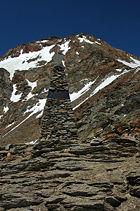
- His physical structure suggested that he was familiar with long walks over hilly terrain. This is not characteristic of the copper-age european of the time. Some have suggested that he was a high-altitude shepherd.
- He had tattoos over areas later determined to be arthritic. Acupuncture, mystical magic? Either way, this suggests he was part of society and had access to the latest “medical” technology.
- Other items found with the Iceman in addition to the copper axe with a yew handle, he had a flint knife with an ash handle, a quiver of 14 arrows with viburnum and dogwood shafts. Two of the arrows, which were broken, were tipped with flint and had fletching (stabilizing vents), while the other 12 were unfinished and untipped. The arrows were found in a quiver with what is presumed to be a bow string, a tool of some sort, and some antler which might have been used for making arrow points. There was also an unfinished yew longbow that was 1.82 metres (72 in) long.
- Also, among Ötzi’s possessions were berries, two birch bark baskets, and two species of polypore mushrooms with leather strings through them. One of these, the birch fungus, is known to have antibacterial properties, and was likely used for medicinal purposes. The other was a type of tinder fungus, included with part of what appeared to be a complex firestarting kit. The kit featured pieces of over a dozen different plants, in addition to flint and pyrite for creating sparks.
- Ötzi had an arrowhead lodged in one shoulder when he died, and a matching small tear on his coat.
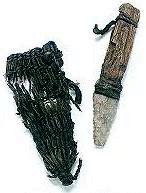
- The arrow’s shaft had been removed before death, and close examination of the body found bruises and cuts to the hands, wrists and chest and cerebral trauma indicative of a blow to the head. One of the cuts was to the base of his thumb that reached down to the bone but had no time to heal before his death. Currently it is believed that death was caused by a blow to the head, though researchers are unsure if this was due to a fall, or from being struck with a rock by another person.
- DNA analysis revealed traces of blood from four other people on his gear: one from his knife, two from the same arrowhead, and a fourth from his coat. Interpretations of the findings were that Ötzi killed two people with the same arrow, and was able to retrieve it on both occasions, and the blood on his coat was from a wounded comrade he may have carried over his back. Ötzi’s unnatural posture in death (frozen body, face down, left arm bent across the chest) suggests that the theory of a solitary death from blood loss, hunger, cold and weakness is untenable. Rather, before death occurred and rigor mortis set in, the Iceman was turned on to his stomach in the effort to remove the arrow shaft.
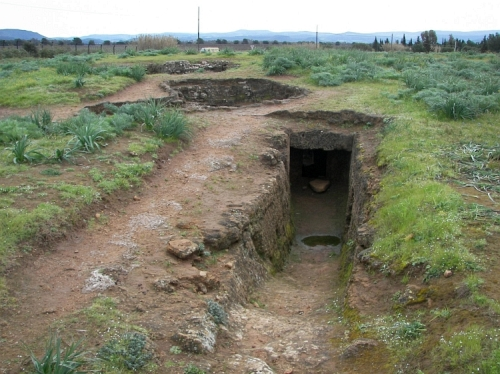
- The DNA evidence suggests that he was assisted by companions who were also wounded; pollen and food analysis suggests that he was out of his home territory. The copper axe could not have been made by him alone. It would have required a concerted group tribal effort to mine, smelt and cast the copper axe head. This may indicate that Ötzi was actually part of an armed raiding party involved in a skirmish, perhaps with a neighboring tribe, and this skirmish had gone badly. It may also indicate that he was ambushed or attacked by a rival tribe’s raiding party on his way to deliver the axe.
- When the Iceman’s mitochondrial DNA was analyzed, it was discovered that he had genetic markers associated with reduced fertility. It has been speculated that this may have affected his social acceptance.
- Using a mixed sequencing procedure based on PCR amplification and 454 sequencing of pooled amplification products, Oetzi became the first complete mitochondrial-genome sequence of a prehistoric European. Compared with 115 related extant lineages from mitochondrial haplogroup K. It turns out that the Iceman belonged to a branch of mitochondrial haplogroup K1 that has not yet been identified in modern European populations. This is the oldest complete Homo sapiens mtDNA genome generated to date. Did his people just die out, become victim of genocide, or dispersed into the european population that has not yet been sampled.
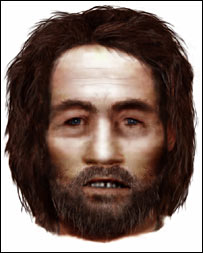
OK, so maybe I didn’t list everything. The analysis of the food he ate was able to place him in a specific valley within days of his death and so on. What I find so interesting is that this is a representative of a very odd cross section of the population at the time. He travelled extensively, was a technical adept, availed himself of the best medical care, was well-dressed, probably didn’t have an immediate family, had friends who did similar activities and enemies with which he did quite a great job of fighting before he was killed. The Ozieri culture (according to mainstream archaeology) were farmers that didn’t travel, were fairly pacifist, and built dolmens. Sounds like there is much more to the reality of life back in 3200 b.c.e. than meets the archaeological spade. This was a serendipitous find, possibly an outlier, but I think it has implications for those who think that a homogenous worldwide civilization existed shortly after the last Neolithic Ice Age.
Posted on October 30, 2008 on 4:06 pm | In Artifacts, Genetics, History, Iconography | 2 Comments2 Comments »
RSS feed for comments on this post.
Leave a comment
 Entries and comments feeds.
Valid XHTML and CSS. ^Top^
Entries and comments feeds.
Valid XHTML and CSS. ^Top^
73 queries. 0.827 seconds.
Powered by WordPress design by John Doe.
Your findings sure stir my proud Luogodoro DNA. We hail from Tula/Ozieri, Sassari, Sardegna. I live in Beverly Hills California and want to have science avail themselves of my specific DNA which has anti desease properties so I understsnd from articles written on the web. My uncle was a real giant and my parents were exceptionally strong. There is much to be said about the derivation and transmition and usage of the word Tula which basically means center of the world. Remember Tula is in Mexico and Scandinavia and Russia etc.
Please contact me if there is some way to further the studies being made with my offered assist. Phone 24/7 @ 310–5576884; Box 1944 Beverly Hills, Ca. 90213. Mind you, we are not of the breed further south and in the region of Barbasggia which I believe was infiltrated by extraneous races. Your work is highly commendable. Looking forward –TRULY = john Giovanni Corda
Comment by john Giovanni Corda — December 14, 2010 #
Comment by John Giovanni Corda — December 11, 2015 #
John,
I am fascinated by findings such as this. I thought i would write an article about it after some research. Nothing more than that. Thanks for the word of support!
-Jeff
Comment by Jeff — December 11, 2015 #